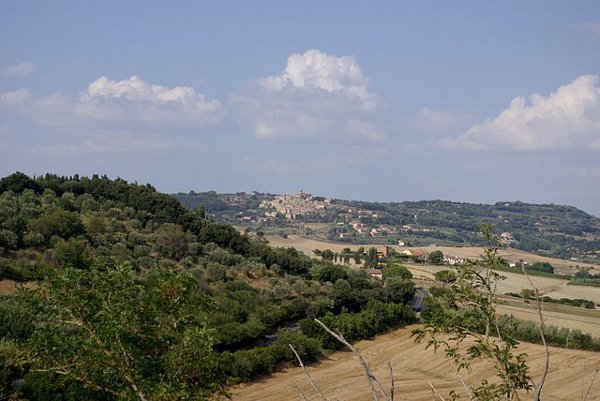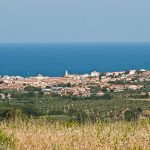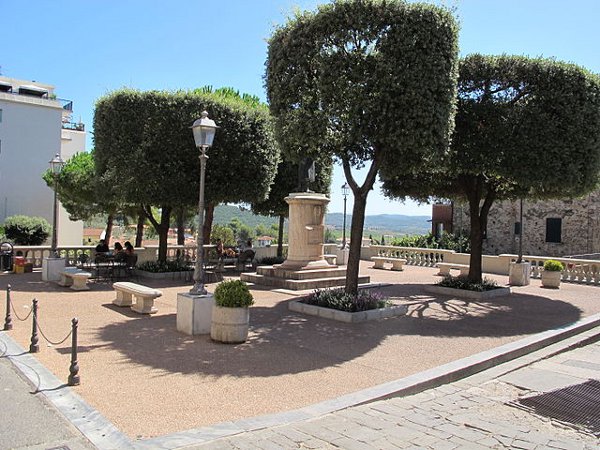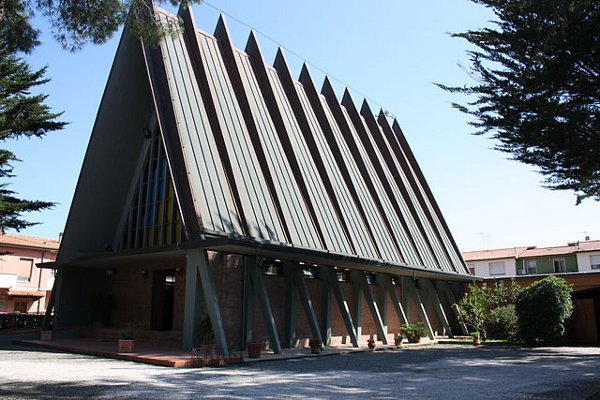Feature is its semi-circular ring structure that descend gently towards the sea, corresponding to the many stages of urban development. And ‘one of the countries that best Cecina Go to maintain the layout of the medieval castle. On the territory have been found remains of Etruscan and Roman settlements, of which some remains can be seen in the country.
The hills of Casale were places of Etruscan settlements and several archaeological finds were made in territorio.Il most important is a tholos tomb, of the fifth century BC, removed and rebuilt in the garden of the Archaeological Museum of Florence. Come from this tomb, among other things, the two oldest objects in alabaster which has been known, probably left from the workshops of Volterra – a patera and a lacrimatoio -, also the Archaeological Museum of Florence. Other exhibits in museums of Volterra and Cecina Fifty. The Roman era is a small villa in Botro della Pieve, the materials of which were reused in some buildings of the country.
The medieval castle is named in documents since 1004 and belonged to the Counts of Gherardesca, which refer to the first documents of sale (in 1004 Gerard and his wife Julia gave it a church and 13 farms “that are in the court of Casale” to the monastery Santa Maria Serena in Chiusdino, in 1008 Gherardo of Gherardo was sold homes, farms and household goods of the district of the parish of St. John of Casale, and Wilda, his wife, other property in the same district, in 1092 a Count Gherardo granted to the monastery Montescudaio a church of Sant’Andrea in Casale).
In fact there were two castles in the area of the same name: Casalvecchio, which remained the only hill of the same name in the southeast of the country, and Casalnuovo, today Casale Maritime. It is not clear what the relationship between the two castles and how long they lived together; oldest documents are certainly to refer to Casalvecchio, and so also a famous letter from the bishop of Volterra, in 1344, in which these tells how the Count Gherardo di Donoratico were sick in the castle of Casale and because of poor air could not heal until they had been taken elsewhere: “We sent them doctors […] and those advised him because the air of Casale was corrupt and of other reasons that if there is not it proceeded, that he was in jeopardy of life and truly according to which ‘doctors we were then told that sickness would not be unsubstantiated if it was not party. ” And ‘This is an early witness to the spread of malaria.
Casalvecchio presumably was destroyed in 1363 during a battle between Pisa and Florence, but probably even before it was gradually abandoned in favor of Casalnuovo that, although not the highest, it was better ventilated and more healthy.
Between the two castles on Botro della Pieve, was the parish church of St. John the Baptist of Casale, which still gives its name to the river and a location. It was the mother church of the surrounding, the only one with a baptismal font, and she did not just head Casalvecchio and Casalnuovo, but also Guardistaiio and Montescadaio. Although it was heavily damaged – in fact, “[…] almost demolished et destructa totum” in the fighting of 1363 and the baptismal font as a result of this war had been transferred to Casalnuovo – it held the title of parish and kept it , apparently, even until the middle of the ‘500. In 1413, at the time of a pastoral visit of the Bishop of Volterra, it turned out “in totum ruined,” that is totally ruined and only the walls were standing, but he was parish and the parish priest. In 1439 the baptisms of all the children of the neighboring castles were held “every Holy Saturday at the baptismal font in the parish of St. John the Baptist in Santo Andrea Casale,” as can be seen from a letter from the Bishop of Volterra, which shows that Sant ‘Andrea housed the baptismal font but do not have the title of parish. While the castles of Casale were under the political domination of the Republic of Pisa, the church depended on the diocese of Volterra.
A Casalvecchio lived from about half of the ‘300 Montescudaio accounts, branch of the family Gherardesca formed at that time in the castle of Montescudaio. One of their palace or fortress still existed in the nineteenth century and is named in the Gazetteer of Repetti. The structure of the castle was a circular plan with a door to the south and antiporti provided with access ramp and dominated by the fortress. To the north was a lookout tower, still visible, but they are not proven other ports. The walls were formed by the same houses they had, and have, very thick walls to the outside and few windows placed only at the top. Inside – as in other medieval settlements – the houses were huddled together without any rule and no respect for the progression of the roads and lack of sufficient aeration. The castle contained within it not only the houses and cellars, the shops of the butcher, the blacksmith, the barber, the oven and the mill, but also the stables and forts for domestic animals (donkeys, pigs, chickens) and some vegetable garden. In addition there was the church with the adjoining cemetery and, in addition to the mansion with stables, stables and warehouses, were the court room and prisons. Outside the walls remained the source with the watering and washing. The church was dedicated to St. Andrew Casalnuovo and is named for the first time in 1305.
In 1406, following the conquest of Pisa from Florence, Casale also, like other countries of the Val di Cecina, submitted to the Florentine Republic. In 1407 he obtained permission from Florence to form a municipality, but contrary to what happened in Montescudaio Guardistallo, could not free himself from the accounts of Gherardesca-Montescudaio who kept their property and jurisdiction. The small community did not give immediately the statutes, but in 1414 he accepted those Montescudaio Guardistallo and also afterwards, since 1490 until 1620, its statutes were always included in those of the other two municipalities.
On the sixteenth and seventeenth centuries are reports of some interest; centuries are characterized by the defense against pirate raids, the fight against malaria which infested the coastal plain and dated back to the countries from periodic famines and epidemics and the social and economic stagnation characterized in these areas the Medici Grand Duchy. All these factors have definitely made it difficult living conditions of the population.
In 1551, Casale had 245 inhabitants.
1642 is the news that the community decided on the fortification of the walls to defend against pirate raids from the sea. In 1648, in the wake of Montescudaio, Casale was given in fief to the Ridolfi and in 1738 became part of the Marquis of Riparbella, given in fief to Count Carlo Ginori.
At the beginning of the eighteenth century campaigns were in a state of extreme poverty and backwardness. Vast lands of the vassal remained reserved for hunting and the woods were advancing. In 1709 “was proposed as it would have been necessary to have the opportunity of a doctor, given the bad air, and indexable patients often die miserably without experiences.” Nevertheless Casale was probably in better shape than many other countries since the Targioni Tozzetti, who visited in 1742, he wrote: “Casale modern age is the biggest, and most of all healthy Castle Marquis. The reason of health is not only a nearby water fountain good, as well as the favorable situation in a transport of high hill, and well ventilated. ” In 1745 the inhabitants were 315.
In 1777, with the reforms of the Grand Duke Peter Leopold, began the process of land redistribution and, consequently, their centralization in the hands of some new wealthy families: Casale emerged in the names of the Chancellors, the Sparapani, the Werewolves and Marchionneschi, which as a result have held power in the town throughout the nineteenth century and into the first half of our century. The concentration of land and the spread of the system of sharecropping led to an increase and an improvement in agricultural production. In the nineteenth century was still raging malaria, there were no houses in the countryside, the wolves were so abundant that in 1810 a government decree freeing the hunting of wolves from any constraint, but the number of inhabitants in the country began to rise: they were 817 in 1833 and twenty years later, in 1854, amounted to 1,070 units in 1861, the number had risen to 1,174. The progressive reclamation of coastal marsh favored agricultural development.
In the second half of the nineteenth century the town underwent some major changes due to the increase of the population in 1854 was demolished to build the southern gateway to the Civic Tower with the clock, in 1872 began the construction of the new church, which involved the ‘ demolition of part of the wall and the old town hall to open a passage to the new road. The old church was converted into a town hall. The cemetery disappeared under the new bell tower, but already in 1855 it was opened a new cemetery on the road to Guardistallo. At the same time the village had grown even outside the walls and 900 was placed at the beginning of the Piazza del Popolo, then square Chancellors. The country assumed more or less its present appearance.
In 1862, Casale, until then known as “Farmhouse in Maremma”, took the name of “House of VaI di Cecina” from 1900 is called “Casale Maritime.” In 1936 the number of inhabitants has reached the maximum limit of 1,583, but in the 50s began the process of migration to cities in the plains that were rapidly developing and guaranteed secure jobs, scheduled times lighter work of those requests to the tenant in the country.
In the early 60’s the phenomenon of the earth was at its peak and the system of sharecropping was disappearing. Especially young people, they settled in the plains or migrated to the cities of northern Italy.
In 1971 the number of inhabitants had fallen to 837. The risk of becoming an “old country” was mitigated only by the fact that many inhabitants risanavano, with the money earned outside the houses of the village, accompanied by modern comforts.
Today Casale has 914 inhabitants. The economy is primarily agricultural and produce wine, olive oil and cereals, there are also a company of beekeeping, a laboratory of furs and other commercial services and dining options. The appearance of the medieval town is well preserved and awareness for the historical values has meant that some modernization of the 60s have been removed, such as coverage of streets in the asphalt that was removed in 1989 by rediscovering the old paved with sandstone .
Taken from the Guide to the Val di Cecina, curated by Susanne Mordhorst, New Image Publishing
https://tuscanysea.com/backoffice/immagini/tuscanysea.com/14-17-5-2013-10-36-161.jpg
https://tuscanysea.com/backoffice/immagini/tuscanysea.com/14-17-5-2013-10-36-162.jpg


















